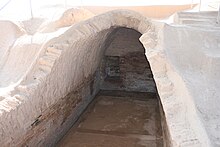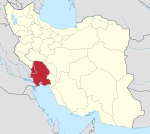Haft Tepe
 Royal Tomb at Haft Tepe | |
 Shown within Iran | |
| Alternative name | Kabnak |
|---|---|
| Location | Khuzestan Province, Iran |
| Coordinates | 32°04′44″N 48°19′35″E / 32.07889°N 48.32639°ECoordinates: 32°04′44″N 48°19′35″E / 32.07889°N 48.32639°E |
| Type | Settlement |
| History | |
| Cultures | Elamite |
| Site notes | |
| Condition | In ruins |
Haft Tepe is an archaeological site situated in the Khuzestan Province in south-western Iran. At this site the remains of the Elamite city of Kabnak were discovered in 1908, and excavations are still carried out.
History[]
The city of Kabnak is mentioned as an important political centre during the reign of the Elamite king Tepti-Ahar, the last king of the Kidinuid dynasty ruling in the 15th century BC. He may also have been buried in the city. After his death the centre of power returned to the old capital Susa, although there is no clear evidence that Kabnak ever held real power at all. Due to the turmoil of this era it is possible the construction of Kabnak was necessary after Tepti-Ahar lost control over Susa, however this theory has not been completely confirmed by solid proof.[1] Some centuries later another city was built at the nearby site of Choqa Zanbil.
Excavations at Haft Tepe revealed a large temple founded by Tepti-Ahar where the god Kirwashir was worshiped. Beneath the temple lay a subterranean funerary complex intended for the king and his family. Skeletal remains were found in the tomb, though it is not certain they belong to royalty. [2] Another large structure found at the site was perhaps the foundations of a ziggurat, along with courtyards and suites of rooms. The temple complex was decorated with bronze plates and wall paintings. Administrative texts belonging to the reigns of Tepti-Ahar and Inshushinak-zunkir-nappipir were also found at the site. Recently some clay statuettes of fertility goddesses have been unearthed at the site.
Archaeology[]
The site is around 1.5 km by 800 meters made up of 14 mounds with the highest being 17 meters high. [3] Haft Tepe was first surveyed by the French archaeologist Jacques de Morgan in 1908. The site was excavated in the period from 1965 to 1979 by a team from the University of Tehran, led by the Iranian archaeologist Ezzat Negahban.[4] Since 2003 excavations have been carried out by a team of German-Iranian archaeologists, including the University of Mainz, University of Kiel and the Iranian Cultural Heritage Organization, headed by Behzad Mofidi in ten seasons through 2013.[5][6][7][8]
In the 2006 season a number of cuneiform administrative tablets were recovered and have now been published. They are primarily inventories.[9]
See also[]
- Cities of the ancient Near East
Notes[]
- ^ Van De Mieroop, Marc: "A History of the Ancient Near East, ca. 3000-323 BC", page 185. Blackwell Publishing, 2007. ISBN 1-4051-4911-6
- ^ [1] Human remains from Haft Tepe, Iran, 2012-2013, Bioarchaeology of the Near East, vol. 12, pp. 55-60, 2018, ISSN 1899-962X
- ^ Ezat O. Negahban, Haft Tepe Roundels: An Example of Middle Elamite Art, American Journal of Archaeology, vol. 88, no. 1, pp. 3-10, 1984
- ^ Negahbaran, Ezat O. (1995): Excavations at Haft Tepe, Iran. Journal of Near Eastern Studies 54(4):293
- ^ B. Mofidi-Nasrabadi, Archäologische Untersuchungen in Haft Tape (Iran), Archäologische Mitteilungen aus Iran und Turan, vol. 35-36, pp. 225-239, 2003-04
- ^ Behzad Mofidi-Nasrabadi, Vorbericht der archäologischen Ausgrabungen der Kampagnen 2005-2007 in Haft Tappeh (Iran), Verlag, 2010, ISBN 978-3-89688-418-3
- ^ Mofidi-Nasrabadi, B, Vorbericht der archäologischen Untersuchungen in den Kampagnen 2008, 2009 und 2010 in Haft Tappeh (Iran), Elamica, vol. 2, pp. 55-159, 2012
- ^ Mofidi-Nasrabadi, B, Vorbericht der archäologischen Untersuchungen in den Kampagnen 2012-2013 in Haft Tappeh (Iran), Elamica, vol. 4, pp. 67-167, 2014
- ^ Prechel, D., Die Tontafeln aus Haft Tappeh 2005-2007, in: B. Mofidi-Nasrabadi, Vorbericht der archäologischen Ausgrabungen der Kampagnen 2005-2007 in Haft Tappeh (Iran), Münster, pp. 51-57, 2010
References[]
- Izzat Allāh Nigāhbān, Excavations at Haft Tepe, Iran, University of Pennsylvania Museum of Archaeology, 1991, ISBN 0-934718-89-X
- P. Herrero, Tablettes administratives de Haft Tépé, Cahiers de la Délégation archéologique francaise en Iran, vol. 6, pp. 93–116, 1976
- P. Herrero and J. J Glassner, Haft-Tépé: Choix de textes I, Iranica Antiqua, vol. 25, pp. 1–45, 1990
- P. Herrero and J. J Glassner, Haft-Tépé: Choix de textes II, Iranica Antiqua, vol. 26, pp. 39–80, 1991
- P. Herrero and J. J Glassner, Haft-Tépé: Choix de textes III, Iranica Antiqua, vol. 28, pp. 97–135, 1993
- P. Herrero and J. J Glassner, Haft-Tépé: Choix de textes IV, Iranica Antiqua, vol. 31, pp. 51–82, 1996
- E. Reiner, Inscription from a Royal Elamite Tomb, Archiv für Orientforschung, vol. 24, pp. 87–102, 1973
External links[]
- Archaeological sites in Iran
- Elam
- Former populated places in Iran
- History of Khuzestan Province
- Buildings and structures in Khuzestan Province

